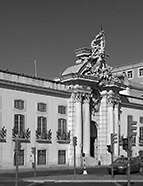

Finally, the king adds: "Considering the importance of such a Deposit: I am pleased to create a Director for its management who, besides the distinguished military knowledge and rank that should qualify him for this role, must also possess personal qualities that make him worthy of My Royal trust." Therefore, on 8 September, the king appointed the director of the Archive, with the following justification: "Considering that for a position of such importance, it is necessary for me to appoint a person who, by his qualities, is worthy of My Royal trust, and who possesses distinguished military knowledge, and the constant displays of Honour and Fidelity towards me have been proven by Dom Pedro Vito de Menezes, Marquis of Marialva; as well as his dedication to the studies of his profession, exemplary assiduousness, zeal, and intelligence with which he has engaged in the commissions of My Royal service with which he has been entrusted, and since I expect him to fulfil the duties with which I entrust him to My great satisfaction, I am pleased to appoint him director of the Military Archive." Although the history of the Archive has often diverged from the essential lines thus defined by the king, its documentary heritage has, in fact, been preserved over the years, constituting today an archival asset of incalculable value for the memory of the Army of Portugal, Brazil, the new Portuguese-speaking African countries, and all the territories that were administered by Portugal. The heirs of this rich heritage today are the Military Engineering Corps and the Military History Archive, as its custodians. These two bodies have been committed to preserving, enhancing, and disseminating the documentary collection in their possession, contributing to the knowledge of Portugal's past, its presence in the world, and the relationships established over five centuries with so many peoples and cultures. Among the documents comprising its heritage, a fundamental aspect of the memory preserved by the Army should be highlighted – the memory of military fortification spread by the adventure of the Portuguese to the four corners of the world. As already seen, in 1924 part of the documentation of this valuable collection was transferred to the Military History Archive, however unfortunately, a division was made between the written parts (mainly transferred) and drawn parts (retained), separating the descriptive memories from their respective charts, maps, and architectural drawings. This is still the situation today, as has been highlighted.
